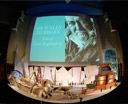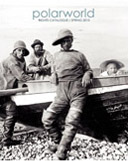 Our ProductsOur Resources |
This website requires the free Flash plugin to be installed.
Polarworld - discover more polar booksThe Arctic Book Review In the Land of White Death: In the Land of White Death: An Epic Story of Survival in the Siberian Arctic Valerian Albanov Reviewed by Paul van Peenen Early in the 20th century a flurry of ships set off on expeditions of discovery in both the southern and northern polar regions to map the final reaches of the globe. Many of the names have become synonymous with polar exploration: Scott, Amundsen, Stefansson, Peary, Shackleton. These men endured unimaginable hardships and deprivation. They routinely faced death and indeed some of them did not survive their ordeals. Yet for all the well-known explorers there are many more whose names we do not know. Valerian Ivanovich Albanov is one such name. The same year Robert Falcon Scott succumbed in Antarctica, a 32-year-old Russian navigator embarked on an expedition that would ultimately prove disastrous. Searching for new Arctic hunting grounds, the Saint Anna, under the command of Georgiy Brusilov, set off from Alexandrovsk, present-day Murmansk, a Russian northern coastal city on the Barents Sea. The intent was to emerge at the other end of the Northeast Passage at Vladivostok. This route had been attempted by many before, starting in the 16th century with Dutch navigator Willem Barentz, followed by Henry Hudson in early in the 17th century before he met his end in the Canadian Arctic looking for the Northwest Passage. It was not until 1879 that the route was successfully completed by Swedish explorer Nils Adolf Erik Nordenskisÿld. Brusilov was hardly up to the challenge. The expedition seemed to be jinxed from the start as he he did not hire a competent crew and was unable to secure the funds necessary for such and undertaking. Despite these setbacks, and the fact that the passage had not been successfully traversed in over 30 years, Brusilov launched the expedition with enough just supplies to feed 30 men for 18 months, but inexplicably did not take on enough antisorbutics, such as citrus fruits, to stave off scurvy. The ship did not leave port until August 28, 1912, a date late enough in the season to guarantee it would become beset in the Arctic ice pack. Less than two months into the voyage, the Saint Anna became trapped in the ice of the Kara Sea, west of the Yamal Peninsula. The ice never relinquished her as the ship drifted north in a zigzag pattern beyond the Franz Josef Archipelago.The summer of 1913 came and went, and after 18 months the ship had drifted 2,400 miles north of any land in the eastern hemisphere. By January 1914, there was still plenty of food, but the wood and coal supply had been exhausted and the only source of fuel was a putrid mixture of bear and seal fat mixed with machine oil. Scurvy had already taken its toll as many of the crew were incapacitated for long periods, and the prospect of waiting for another summer to be delivered from their frozen hell was probably too much for many of the crew. It certainly was for Albanov, who had been at odds with his commander for months. Brusilov's senior by three years, Albanov finally decided that in order to survive, he would need to leave the ship. He believed that the only hope was to reach Franz Josef Land which he knew lay somewhere to the south. The only map of this little-known region on board the Saint Anna was a page from Fridtjof Nansen's Farthest North, a book published 20 years before with most of Franz Josef Land indicated by hypothetical dotted lines. On January 9, 1914, Albanov requested permission to build a kayak and sledge and leave the ship. Other crew members decided there was merit in Albanov's plan and they too built kayaks and sledges. Brusilov grudgingly consented and on April 10, 1914, Albanov and 13 companions left the Saint Anna but three of them turn back after only a few days. This is where Albanov chose to begin his narrative, ignoring the previous months of drift locked in the ice. Because of the narrow focus of the book, Albanov's story is a compelling one. It describes the 90-day ordeal the ten men, commanded by Albanov, went through as they faced many hardships and great danger from the ever-shifting ice. The diary describes their 235-mile journey to Cape Flora. What makes this such an incredible journey – on par with the one Shackleton undertook to save his men from certain death – is that Albanov had no accurate way to determine longitude and he had to guess whether Franz Josef Land lay to the east or west of him. He guessed east and he was right. Albanov's narrative is taut and suspenseful. It is filled with continuous peril from shifting ice, attacks by polar bears and walrus to disintegrating ice floes, blizzards, snowblindness and lack of food. Through it all, it is clear that Albanov is a born leader. He convinces his men to continue hauling the kayaks on their sledges even though they are cumbersome and heavy. Albanov had the foresight to realize that without the kayaks they would surely perish in the constantly shifting ice-bound Arctic Ocean and the waters around the Franz Josef Archipelago. Albanov's writing is lean and his humility shines through on many occasions. His June 1, 1914 entry reads: Anyone who has been in a position to observe the immensity of Nature's power feels intimidated by his own perceptions – as if giants were testing their strength by playing with each other on a colossal chessboard. I will try to give an example: In exploring the region to the south-southeast, we were surprised to discover ski tracks on one of the ice floes. Closer examination convinced us that we were looking at our own tracks, and that this ice floe had caught up with us as a result of a change of current. How is one supposed to proceed over this sort of ice? On the surface, one achieves no more success than a squirrel in a wheel-cage. On June 9 Albanov finally sights land but getting there proved to be another matter entirely. He complains that his companions seem apathetic. He is puzzled by their attitude and can not understand why they "dragged their feet instead of striding bravely forward." Two of the men sneak away during the night with some of the group's equipment and supplies. Albanov describes the betrayal and leaves no doubt how he would deal swiftly and harshly with the mutineers, but realizes it would be foolish to try and chase after them. On June 25, within striking distance of land, a storm blows the ice floes apart and the remaining party is scattered. Albanov's description is sparing but lacks no details and the reader is caught up in the drama quite easily. Just imagine being stuck on a small piece of drifting ice that gets battered to pieces and having to climb into an unstable kayak that is easily damaged by sharp edges of the shattering ice. Albanov leaves little to the imagination. By some miracle, the men are reunited and manage to scramble up a glacier with their sleds and kayaks and walk on to their "land of deliverance." With their food supply mostly gone, the men now depended completely on what game they could shoot. A colony of eider ducks brings much needed relief as the men are able to gather as many eggs as they desire. While hunting, Albanov stumbles upon the two thieves and the man's character is put to the test. Albanov is overcome with emotion and decides to pardon the men, realizing that had he met them on the ice a few hours earlier, he would have summarily executed them for mutiny. Under Albanov's leadership, the party continues to make its way to Cape Flora hoping to find cabins and a cache left behind by the 1897 expedition of Frederick G. Jackson aboard the Windward. Even though the party had gained land, their troubles were far from over as scurvy killed one man and severely incapacitated three others. Albanov split the party into two groups: four men would travel with sledges by land, the other five in two kayaks. With their food supply all but gone, the men were reduced to eating raw ducks they were able to shoot while travelling. Despite the hardships, Albanov manages to maintain his diary throughout. His writing remains unambiguous and his observations of the landscape are filled with the smallest detail. He also speculates about their fate if they are unable to reach Cape Flora, or if they do, but find nothing there, what will they do next? Go to Svalbard? No sooner had we left the Saint Anna than our sledges were already falling apart; now they consist only of fragments and splinters, held together with wire and string. Our clothes are nothing but filthy rags soaked in seal oil and swarming with lice. Our supplies consist of two pounds of salt. No, absolutely not! The kayakers decide to keep moving when the sledge party does not meet them at Cape Grant. Albanov, ever the pragmatist, knows they will all perish if they do not reach the Jackson camp. En route from Bell Island to Northbrook Island, a sudden storm separates the two kayaks and Albanov and his companion, Alexander Konrad, are forced to climb onto an iceberg to wait out the storm. They lose contact with the three men in the other kayak, their fate unknown but easily imagined. Albanov and Konrad nearly drown while sleeping when their iceberg disintegrates, but miraculously they manage to crawl into their kayak and paddle back to Bell Island, the closest land. Days later, the two desperate men find salvation at the Jackson camp at Cape Flora with intact shelter and plenty of provisions. Despite hoping for a reunion with the other kayak party, Albanov and Konrad know they are the lone survivors and prepare to spend the winter at Cape Flora, fixing the cabin and stocking up all the supplies they can find, when out of nowhere a ship appears and the two men are rescued. Albanov's narrative of his three-month ordeal is one of the greatest stories of survival in Arctic letters, but until recently languished in Russian and French libraries. It was published in Russia in 1917 and in France in 1928. But thanks to author David Roberts and French publisher Michel GuZÿrin, who had been tipped off by explorer and Arctic connoisseur Christian de Marlave, Albanov's book was translated into English for the first time in 2000. Albanov's story may never reach the status of the likes of Shackleton or Scott, but for devotees of Arctic literature, this is a must read. Sadly, Albanov died in 1919, only five years following his heroic struggle for survival. Konrad died in 1940. The fate of the others, including Brusilov and the ones who stayed behind on the Saint Anna, is unknown. Not a trace has ever been found. |
|
||
follow us  | join us | join us  | home | contact | home | contact
|
||||
|
© Copyright Polarworld Ltd
SiteWizard.co.uk Web Site Design Company |
||||


